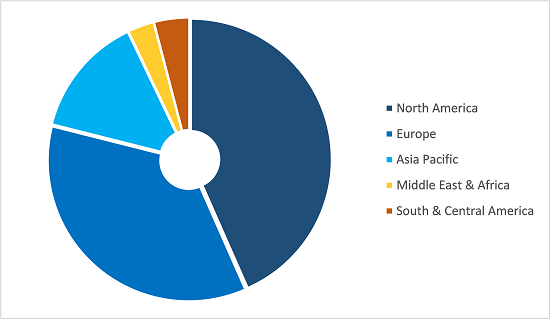The North America farm animal drugs market is expected to reach US$ 12,454.7 million by 2028 from US$ 7,848.8 million in 2021. The market is estimated to grow at a CAGR of 6.8% from 2021–2028.
Consumers are becoming increasingly aware and concerned about the welfare of animals raised for food. This has put pressure on suppliers to ensure that animals entering their systems are treated humanely. Measures are being taken for addressing such demand. Only one drug is approved in the US to control interdigital phlegmon (foot rot) pain in non-lactating cattle. Therefore, using medications for pain management in elective procedures, such as dehorning and castration, in cattle or analgesia in lactating dairy cows and pigs is considered an extra-label drug use. It is regulated as per the clarification on the use of veterinary drugs law. Flunixin, meloxicam, and ketoprofen are nonsteroidal anti-inflammatory drugs with supportive research on on-farm analgesia. Several products, such as local and regional anesthetics, opioids, and nonsteroidal anti-inflammatory drugs (NSAIDs), are available in the market to relieve pain in animals. Thus, such advancements are accelerating growth of the North America farm animal drugs marketSome associations, such as the Canadian Cattlemen's Association, has called farmers to put cattle on maintenance rations rather than finishing rations to limit feedlot placements, coping with the closure of processing plants, and limited market capacities. Indeed, many farmers failed to obtain essential veterinary services, including routine health check-ins, drugs, vaccines, and testing and diagnostic tools. Thus, disease control of animals has become an additional challenge conflicting with animal welfare aspects. Unfortunately, the effect of COVID-19 on the activities related to animal healthcare is not restricted only on the farm-scale, but there are also national and international restrictions. The pandemic's impact on the livestock supply chain affected the local marketing process by reducing marketing opportunities, blocking of import/export activity, and lowering purchasing power, and consumers', demand (misconception regarding animal products safety and reduced consumers' income). All of these interruptions in the livestock supply chain put the producers (farmers) at risk of not being able to continue in the field. The limitation of movements and the disruption of national and international trade routes drive to a substantial decrease in vital livestock farming materials and facilities, such as feed materials, replacement stocks (e.g., day-old chicks, piglets, gilts, heifers, and semen straws), drugs and vaccines, feed additives, and other livestock farming inputs. Thus, Covid-19 has a negative impact on the market’s growth.
With the new features and technologies, vendors can attract new customers and expand their footprints in emerging markets. This factor is likely to drive the farm animal drugs market. The North America farm animal drugs market is expected to grow at a good CAGR during the forecast period.
North America Farm animal drugs Market Revenue and Forecast to 2028 (US$ Million)
North America Farm animal drugs Market Revenue and Forecast to 2028 (US$ Million)

- Sample PDF showcases the content structure and the nature of the information with qualitative and quantitative analysis.
- Request discounts available for Start-Ups & Universities
North America Farm Animal Drugs Market Segmentation
By Product Type

- Sample PDF showcases the content structure and the nature of the information with qualitative and quantitative analysis.
- Request discounts available for Start-Ups & Universities
North America Farm Animal Drugs Market Segmentation
By Product Type
- Anti-Infective
- Parasiticides
- Anti-inflammatory
- Anesthetics
- Analgesics
- Hormones and Related Products
- Others
By Animal Type
- Livestock Animal
- Equine
By Route of Administration
- Oral
- Parenteral
- Topical
- Others
By Distribution Channel
- Veterinary Hospitals
- Veterinary Clinics
- Pharmacies and Drug Stores
- Others
By Country
- North America
- US
- Canada
- Mexico
Companies Mentioned
- PHIBRO ANIMAL HEALTH CORPORATION
- Zoetis Inc.
- Ceva
- Elanco
- Virbac
- INTAS PHARMACEUTICALS LTD.
- Alembic Pharmaceuticals Limited
- Boehringer Ingelheim International GmbH
- MSD Animal Health

Report Coverage
Revenue forecast, Company Analysis, Industry landscape, Growth factors, and Trends

Segment Covered
This text is related
to segments covered.

Regional Scope
North America, Europe, Asia Pacific, Middle East & Africa, South & Central America

Country Scope
This text is related
to country scope.
1. Introduction
1.1 Scope of the Study
1.2 The Insight Partners Research Report Guidance
1.3 Market Segmentation
1.3.1 North America Farm Animal Drugs Market – By Product Type
1.3.2 North America Farm Animal Drugs Market – By Animal Type
1.3.3 North America Farm Animal Drugs Market – By Route of Administration
1.3.4 North America Farm Animal Drugs Market – By Distribution Channel
1.3.5 North America Farm Animal Drugs Market – By Country
2. North America Farm Animal Drugs Market – Key Takeaways
3. Research Methodology
3.1 Coverage
3.2 Secondary Research
3.3 Primary Research
4. Farm Animal Drugs Market– Market Landscape
4.1 Overview
4.2 PEST Analysis
4.2.1 North America – PEST Analysis
4.3 Expert Opinions
5. Farm Animal Drugs Market– Key Market Dynamics
5.1 Market Drivers
5.1.1 Growing Use of Pain Management Drugs in Farm Animals
5.1.2 Rising Foodborne Diseases and Infections
5.1.3 Surging Demand for Quality Pharmaceuticals and Food Security
5.2 Market Restraints
5.2.1 Side Effects of Drugs in Animals
5.2.2 Strict Government Rules Related to Usage of Farm Animal Drugs
5.3 Market Opportunities
5.3.1 Growing Body of Research in Drug Development
5.3.2 Increasing Demand for Livestock from Emerging Economies
5.4 Future Trends
5.4.1 Rising Awareness of Diagnosis and Treatment of Variety of Infectious Diseases
5.5 Impact Analysis
6. Farm Animal Drugs Market – North America Analysis
6.1 North America Farm Animal Drugs Market Revenue Forecast and Analysis
7. Farm Animal Drugs Market Analysis – By Product Type
7.1 Overview
7.2 Farm Animal Drugs Market Revenue Share, by Product Type (2020 and 2028)
7.3 Anti-Infectives
7.3.1 Overview
7.3.2 Anti-Infectives: Farm Animal Drugs Market – Revenue and Forecast to 2028 (US$ Million)
7.4 Parasiticides
7.4.1 Overview
7.4.2 Parasiticides: Farm Animal Drugs Market – Revenue and Forecast to 2028 (US$ Million)
7.4.2.1 Endo-parasiticides
7.4.2.1.1 Overview
7.4.2.1.2 Endo-parasiticides Market Revenue and Forecast to 2028 (US$ Million)
7.4.2.2 Ecto-parasiticides
7.4.2.2.1 Overview
7.4.2.2.2 Ecto-parasiticides Market Revenue and Forecast to 2028 (US$ Million)
7.4.2.3 Endectocides
7.4.2.3.1 Overview
7.4.2.3.2 Endectocides Market Revenue and Forecast to 2028 (US$ Million)
7.5 Anti-inflammatory
7.5.1 Overview
7.5.2 Anti-inflammatory: Farm Animal Drugs Market – Revenue and Forecast to 2028 (US$ Million)
7.6 Anesthetics
7.6.1 Overview
7.6.2 Anesthetics: Farm Animal Drugs Market – Revenue and Forecast to 2028 (US$ Million)
7.7 Analgesics
7.7.1 Overview
7.7.2 Analgesics: Farm Animal Drugs Market – Revenue and Forecast to 2028 (US$ Million)
7.8 Hormones and Related Products
7.8.1 Overview
7.8.2 Hormones and Related Product: Farm Animal Drugs Market – Revenue and Forecast to 2028 (US$ Million)
7.9 Others
7.9.1 Overview
7.9.2 Others: Farm Animal Drugs Market – Revenue and Forecast to 2028 (US$ Million)
8. Farm Animal Drugs Market Analysis – By Animal Type
8.1 Overview
8.2 Farm Animal Drugs Market Revenue Share, by Animal Type (2020 and 2028)
8.3 Livestock Animal
8.3.1 Overview
8.3.2 Livestock Animal: Farm Animal Drugs Market – Revenue and Forecast to 2028 (US$ Million)
8.3.2.1 Ruminants
8.3.2.1.1 Overview
8.3.2.1.2 Ruminants Market Revenue and Forecast to 2028 (US$ Million)
8.3.2.2 Swine
8.3.2.2.1 Overview
8.3.2.2.2 Swine Market Revenue and Forecast to 2028 (US$ Million)
8.3.2.3 Poultry
8.3.2.3.1 Overview
8.3.2.3.2 Poultry Market Revenue and Forecast to 2028 (US$ Million)
8.4 Equine
8.4.1 Overview
8.4.2 Equine: Farm Animal Drugs Market – Revenue and Forecast to 2028 (US$ Million)
9. Farm Animal Drugs Market Analysis – By Route of Administration
9.1 Overview
9.2 Farm Animal Drugs Market Revenue Share, by Route of Administration (2020 and 2028)
9.3 Oral
9.3.1 Overview
9.3.2 Oral: Farm Animal Drugs Market – Revenue and Forecast to 2028 (US$ Million)
9.4 Parenteral
9.4.1 Overview
9.4.2 Parenteral: Farm Animal Drugs Market – Revenue and Forecast to 2028 (US$ Million)
9.5 Topical
9.5.1 Overview
9.5.2 Topical: Farm Animal Drugs Market – Revenue and Forecast to 2028 (US$ Million)
9.6 Others
9.6.1 Overview
9.6.2 Others: Farm Animal Drugs Market – Revenue and Forecast to 2028 (US$ Million)
10. Farm Animal Drugs Market Analysis – By Distribution Channel
10.1 Overview
10.2 Farm Animal Drugs Market Share, by Distribution Channel, 2020 and 2028, (%)
10.3 Veterinary Hospitals
10.3.1 Overview
10.3.2 Veterinary Hospitals: Farm Animal Drugs Market – Revenue and Forecast to 2028 (US$ Million)
10.4 Veterinary Clinics
10.4.1 Overview
10.4.2 Veterinary Clinics: Farm Animal Drugs Market – Revenue and Forecast to 2028 (US$ Million)
10.5 Pharmacies and Drug Stores
10.5.1 Overview
10.5.2 Pharmacies and Drug Stores: Farm Animal Drugs Market – Revenue and Forecast to 2028 (US$ Million)
10.6 Others
10.6.1 Overview
10.6.2 Others: Farm Animal Drugs Market – Revenue and Forecast to 2028 (US$ Million)
11. North America Farm Animal Drugs Market – Geographic Analysis
11.1 North America: Farm Animal Drugs Market
11.1.1 Overview
11.1.2 North America: Farm Animal Drugs Market, by Country, 2021 & 2028 (%)
11.1.2.1 US: Farm Animal Drugs Market– Revenue and Forecast to 2028 (USD Million)
11.1.2.1.1 US: Farm Animal Drugs Market – Revenue and Forecast to 2028 (USD Million)
11.1.2.1.2 US: Farm Animal Drugs Market, by Product Type, 2019–2028 (USD Million)
11.1.2.1.2.1 US: Farm Animal Drugs Market, by Parasiticides, 2019–2028 (USD Million)
11.1.2.1.3 US: Farm Animal Drugs Market, by Animal Type, 2019–2028 (USD Million)
11.1.2.1.3.1 US: Farm Animal Drugs Market, by Livestock Animal, 2019–2028 (USD Million)
11.1.2.1.4 US: Farm Animal Drugs Market, by Route of Administration, 2019–2028 (USD Million)
11.1.2.1.5 US: Farm Animal Drugs Market, by Distribution Channel, 2019–2028 (USD Million)
11.1.2.2 Canada: Farm Animal Drugs Market – Revenue and Forecast to 2028 (USD Million)
11.1.2.2.1 Canada: Farm Animal Drugs Market – Revenue and Forecast to 2028 (USD Million)
11.1.2.2.2 Canada: Farm Animal Drugs Market, by Product Type, 2019–2028 (USD Million)
11.1.2.2.2.1 Canada: Farm Animal Drugs Market, by Parasiticides, 2019–2028 (USD Million)
11.1.2.2.3 Canada: Farm Animal Drugs Market, by Animal Type, 2019–2028 (USD Million)
11.1.2.2.3.1 Canada: Farm Animal Drugs Market, by Livestock Animal, 2019–2028 (USD Million)
11.1.2.2.4 Canada: Farm Animal Drugs Market, by Route of Administration, 2019–2028 (USD Million)
11.1.2.2.5 Canada: Farm Animal Drugs Market, by Distribution Channel, 2019–2028 (USD Million)
11.1.2.3 Mexico: Farm Animal Drugs Market – Revenue and Forecast to 2028 (USD Million)
11.1.2.3.1 Mexico: Farm Animal Drugs Market – Revenue and Forecast to 2028 (USD Million)
11.1.2.3.2 Mexico: Farm Animal Drugs Market, by Product Type – 2019–2028 (USD Million)
11.1.2.3.2.1 Mexico: Farm Animal Drugs Market, by Parasiticides, 2019–2028 (USD Million)
11.1.2.3.3 Mexico: Farm Animal Drugs Market, by Animal Type, 2019–2028 (USD Million)
11.1.2.3.3.1 Mexico: Farm Animal Drugs Market, by Livestock Animal, 2019–2028 (USD Million)
11.1.2.3.4 Mexico: Farm Animal Drugs Market, by Route of Administration, 2019–2028 (USD Million)
11.1.2.3.5 Mexico: Farm Animal Drugs Market, by Distribution Channel, 2019–2028 (USD Million)
12. Impact Of COVID-19 Pandemic on Farm Animal Drugs Market
12.1 North America: Impact Assessment of COVID-19 Pandemic
13. Farm Animal Drugs Market–Industry Landscape
13.1 Overview
13.2 Growth Strategies in the Farm Animal Drugs Market (%)
13.3 Organic Developments
13.3.1 Overview
13.4 Inorganic Developments
13.4.1 Overview
14. Company Profiles
14.1 PHIBRO ANIMAL HEALTH CORPORATION
14.1.1 Key Facts
14.1.2 Business Description
14.1.3 Products and Services
14.1.4 Financial Overview
14.1.5 SWOT Analysis
14.1.6 Key Developments
14.2 Zoetis Inc.
14.2.1 Key Facts
14.2.2 Business Description
14.2.3 Products and Services
14.2.4 Financial Overview
14.2.5 SWOT Analysis
14.2.6 Key Developments
14.3 Ceva
14.3.1 Key Facts
14.3.2 Business Description
14.3.3 Products and Services
14.3.4 Financial Overview
14.3.5 SWOT Analysis
14.3.6 Key Developments
14.4 Elanco
14.4.1 Key Facts
14.4.2 Business Description
14.4.3 Products and Services
14.4.4 Financial Overview
14.4.5 SWOT Analysis
14.4.6 Key Developments
14.5 Virbac
14.5.1 Key Facts
14.5.2 Business Description
14.5.3 Products and Services
14.5.4 Financial Overview
14.5.5 SWOT Analysis
14.5.6 Key Developments
14.6 INTAS PHARMACEUTICALS LTD.
14.6.1 Key Facts
14.6.2 Business Description
14.6.3 Products and Services
14.6.4 Financial Overview
14.6.5 SWOT Analysis
14.6.6 Key Developments
14.7 Alembic Pharmaceuticals Limited
14.7.1 Key Facts
14.7.2 Business Description
14.7.3 Products and Services
14.7.4 Financial Overview
14.7.5 SWOT Analysis
14.7.6 Key Developments
14.8 Boehringer Ingelheim International GmbH
14.8.1 Key Facts
14.8.2 Business Description
14.8.3 Products and Services
14.8.4 Financial Overview
14.8.5 SWOT Analysis
14.8.6 Key Developments
14.9 MSD Animal Health
14.9.1 Key Facts
14.9.2 Business Description
14.9.3 Products and Services
14.9.4 Financial Overview
14.9.5 SWOT Analysis
14.9.6 Key Developments
15. Appendix
15.1 About The Insight Partners
15.2 Glossary of Terms
LIST OF TABLES
Table 1. US Farm Animal Drugs Market, by Product Type – Revenue and Forecast to 2028 (USD Million)
Table 2. US Farm Animal Drugs Market, by Parasiticides – Revenue and Forecast to 2028 (USD Million)
Table 3. US Farm Animal Drugs Market, by Animal Type – Revenue and Forecast to 2028 (USD Million)
Table 4. US Farm Animal Drugs Market, by Livestock Animal – Revenue and Forecast to 2028 (USD Million)
Table 5. US Farm Animal Drugs Market, by Route of Administration – Revenue and Forecast to 2028 (USD Million)
Table 6. US Farm Animal Drugs Market, by Distribution Channel – Revenue and Forecast to 2028 (USD Million)
Table 7. Canada Farm Animal Drugs Market, by Product Type – Revenue and Forecast to 2028 (USD Million)
Table 8. Canada Farm Animal Drugs Market, by Parasiticides – Revenue and Forecast to 2028 (USD Million)
Table 9. Canada Farm Animal Drugs Market, by Animal Type – Revenue and Forecast to 2028 (USD Million)
Table 10. Canada Farm Animal Drugs Market, by Livestock Animal – Revenue and Forecast to 2028 (USD Million)
Table 11. Canada Farm Animal Drugs Market, by Route of Administration – Revenue and Forecast to 2028 (USD Million)
Table 12. Canada Farm Animal Drugs Market, by Distribution Channel – Revenue and Forecast to 2028 (USD Million)
Table 13. Mexico Farm Animal Drugs Market, by Product Type – Revenue and Forecast to 2028 (USD Million)
Table 14. Mexico Farm Animal Drugs Market, by Parasiticides – Revenue and Forecast to 2028 (USD Million)
Table 15. Mexico Farm Animal Drugs Market, by Animal Type – Revenue and Forecast to 2028 (USD Million)
Table 16. Mexico Farm Animal Drugs Market, by Livestock Animal – Revenue and Forecast to 2028 (USD Million)
Table 17. Mexico Farm Animal Drugs Market, by Route of Administration – Revenue and Forecast to 2028 (USD Million)
Table 18. Mexico Farm Animal Drugs Market, by Distribution Channel – Revenue and Forecast to 2028 (USD Million)
Table 19. Organic Developments in the Farm Animal Drugs Market
Table 20. Inorganic Developments in the Farm Animal Drugs Market
Table 21. Glossary of Terms, Farm Animal Drugs Market
LIST OF FIGURES
Figure 1. Farm Animal Drugs Market Segmentation
Figure 2. North America Farm Animal Drugs Market Overview
Figure 3. Parasiticides Held the Largest Share of the Product Type Segment in Farm Animal Drugs Market
Figure 4. US to Show Significant Growth During Forecast Period
Figure 5. North America Farm Animal Drugs Market, Industry Landscape
Figure 6. North America PEST Analysis
Figure 7. Farm Animal Drugs Market Impact Analysis of Driver and Restraints
Figure 8. North America Farm Animal Drugs Market– Revenue Forecast and Analysis – 2020- 2028
Figure 9. Farm Animal Drugs Market Revenue Share, by Product Type (2020 and 2028)
Figure 10. Anti-Infective: Farm Animal Drugs Market – Revenue and Forecast to 2028 (US$ Million)
Figure 11. Parasiticides: Farm Animal Drugs Market – Revenue and Forecast to 2028 (US$ Million)
Figure 12. Endo-parasiticides Market Revenue and Forecasts to 2028 (US$ Million)
Figure 13. Ecto-parasiticides Market Revenue and Forecasts to 2028 (US$ Million)
Figure 14. Endectocides Market Revenue and Forecasts to 2028 (US$ Million)
Figure 15. Anti-inflammatory: Farm Animal Drugs Market – Revenue and Forecast to 2028 (US$ Million)
Figure 16. Anesthetics: Farm Animal Drugs Market – Revenue and Forecast to 2028 (US$ Million)
Figure 17. Analgesics: Farm Animal Drugs Market – Revenue and Forecast to 2028 (US$ Million)
Figure 18. Hormones and Related Product: Farm Animal Drugs Market – Revenue and Forecast to 2028 (US$ Million)
Figure 19. Others: Farm Animal Drugs Market – Revenue and Forecast to 2028 (US$ Million)
Figure 20. Farm Animal Drugs Market Revenue Share, by Animal Type (2020 and 2028)
Figure 21. Livestock Animal: Farm Animal Drugs Market – Revenue and Forecast to 2028 (US$ Million)
Figure 22. Ruminants Market Revenue and Forecasts to 2028 (US$ Million)
Figure 23. Swine Market Revenue and Forecasts to 2028 (US$ Million)
Figure 24. Poultry Market Revenue and Forecasts to 2028 (US$ Million)
Figure 25. Equine: Farm Animal Drugs Market – Revenue and Forecast to 2028 (US$ Million)
Figure 26. Farm Animal Drugs Market Revenue Share, by Route of Administration (2020 and 2028)
Figure 27. Oral: Farm Animal Drugs Market – Revenue and Forecast to 2028 (US$ Million)
Figure 28. Parenteral: Farm Animal Drugs Market – Revenue and Forecast to 2028 (US$ Million)
Figure 29. Topical: Farm Animal Drugs Market – Revenue and Forecast to 2028 (US$ Million)
Figure 30. Others: Farm Animal Drugs Market – Revenue and Forecast to 2028 (US$ Million)
Figure 31. Farm Animal Drugs Market Share, by Distribution Channel, 2020 and 2028 (%)
Figure 32. Veterinary Hospitals: Farm Animal Drugs Market – Revenue and Forecast to 2028 (US$ Million)
Figure 33. Veterinary Clinics: Farm Animal Drugs Market – Revenue and Forecast to 2028 (US$ Million)
Figure 34. Pharmacies and Drug Stores: Farm Animal Drugs Market – Revenue and Forecast to 2028 (US$ Million)
Figure 35. Others: Farm Animal Drugs Market – Revenue and Forecast to 2028 (US$ Million)
Figure 36. North America: Farm Animal Drugs Market, by Key Country – Revenue (2021) (USD Million)
Figure 37. North America: Farm Animal Drugs Market, by Country, 2021 & 2028 (%)
Figure 38. US: Farm Animal Drugs Market – Revenue and Forecast to 2028 (USD Million)
Figure 39. Canada: Farm Animal Drugs Market – Revenue and Forecast to 2028 (USD Million)
Figure 40. Mexico: Farm Animal Drugs Market – Revenue and Forecast to 2028 (USD Million)
Figure 41. Impact of COVID-19 Pandemic in North American Country Markets
Figure 42. Growth Strategies in the Farm Animal Drugs Market (%)
- PHIBRO ANIMAL HEALTH CORPORATION
- Zoetis Inc.
- Ceva
- Elanco
- Virbac
- INTAS PHARMACEUTICALS LTD.
- Alembic Pharmaceuticals Limited
- Boehringer Ingelheim International GmbH
- MSD Animal Health
The Insight Partners performs research in 4 major stages: Data Collection & Secondary Research, Primary Research, Data Analysis and Data Triangulation & Final Review.
- Data Collection and Secondary Research:
As a market research and consulting firm operating from a decade, we have published many reports and advised several clients across the globe. First step for any study will start with an assessment of currently available data and insights from existing reports. Further, historical and current market information is collected from Investor Presentations, Annual Reports, SEC Filings, etc., and other information related to company’s performance and market positioning are gathered from Paid Databases (Factiva, Hoovers, and Reuters) and various other publications available in public domain.
Several associations trade associates, technical forums, institutes, societies and organizations are accessed to gain technical as well as market related insights through their publications such as research papers, blogs and press releases related to the studies are referred to get cues about the market. Further, white papers, journals, magazines, and other news articles published in the last 3 years are scrutinized and analyzed to understand the current market trends.
- Primary Research:
The primarily interview analysis comprise of data obtained from industry participants interview and answers to survey questions gathered by in-house primary team.
For primary research, interviews are conducted with industry experts/CEOs/Marketing Managers/Sales Managers/VPs/Subject Matter Experts from both demand and supply side to get a 360-degree view of the market. The primary team conducts several interviews based on the complexity of the markets to understand the various market trends and dynamics which makes research more credible and precise.
A typical research interview fulfils the following functions:
- Provides first-hand information on the market size, market trends, growth trends, competitive landscape, and outlook
- Validates and strengthens in-house secondary research findings
- Develops the analysis team’s expertise and market understanding
Primary research involves email interactions and telephone interviews for each market, category, segment, and sub-segment across geographies. The participants who typically take part in such a process include, but are not limited to:
- Industry participants: VPs, business development managers, market intelligence managers and national sales managers
- Outside experts: Valuation experts, research analysts and key opinion leaders specializing in the electronics and semiconductor industry.
Below is the breakup of our primary respondents by company, designation, and region:

Once we receive the confirmation from primary research sources or primary respondents, we finalize the base year market estimation and forecast the data as per the macroeconomic and microeconomic factors assessed during data collection.
- Data Analysis:
Once data is validated through both secondary as well as primary respondents, we finalize the market estimations by hypothesis formulation and factor analysis at regional and country level.
- 3.1 Macro-Economic Factor Analysis:
We analyse macroeconomic indicators such the gross domestic product (GDP), increase in the demand for goods and services across industries, technological advancement, regional economic growth, governmental policies, the influence of COVID-19, PEST analysis, and other aspects. This analysis aids in setting benchmarks for various nations/regions and approximating market splits. Additionally, the general trend of the aforementioned components aid in determining the market's development possibilities.
- 3.2 Country Level Data:
Various factors that are especially aligned to the country are taken into account to determine the market size for a certain area and country, including the presence of vendors, such as headquarters and offices, the country's GDP, demand patterns, and industry growth. To comprehend the market dynamics for the nation, a number of growth variables, inhibitors, application areas, and current market trends are researched. The aforementioned elements aid in determining the country's overall market's growth potential.
- 3.3 Company Profile:
The “Table of Contents” is formulated by listing and analyzing more than 25 - 30 companies operating in the market ecosystem across geographies. However, we profile only 10 companies as a standard practice in our syndicate reports. These 10 companies comprise leading, emerging, and regional players. Nonetheless, our analysis is not restricted to the 10 listed companies, we also analyze other companies present in the market to develop a holistic view and understand the prevailing trends. The “Company Profiles” section in the report covers key facts, business description, products & services, financial information, SWOT analysis, and key developments. The financial information presented is extracted from the annual reports and official documents of the publicly listed companies. Upon collecting the information for the sections of respective companies, we verify them via various primary sources and then compile the data in respective company profiles. The company level information helps us in deriving the base number as well as in forecasting the market size.
- 3.4 Developing Base Number:
Aggregation of sales statistics (2020-2022) and macro-economic factor, and other secondary and primary research insights are utilized to arrive at base number and related market shares for 2022. The data gaps are identified in this step and relevant market data is analyzed, collected from paid primary interviews or databases. On finalizing the base year market size, forecasts are developed on the basis of macro-economic, industry and market growth factors and company level analysis.
- Data Triangulation and Final Review:
The market findings and base year market size calculations are validated from supply as well as demand side. Demand side validations are based on macro-economic factor analysis and benchmarks for respective regions and countries. In case of supply side validations, revenues of major companies are estimated (in case not available) based on industry benchmark, approximate number of employees, product portfolio, and primary interviews revenues are gathered. Further revenue from target product/service segment is assessed to avoid overshooting of market statistics. In case of heavy deviations between supply and demand side values, all thes steps are repeated to achieve synchronization.
We follow an iterative model, wherein we share our research findings with Subject Matter Experts (SME’s) and Key Opinion Leaders (KOLs) until consensus view of the market is not formulated – this model negates any drastic deviation in the opinions of experts. Only validated and universally acceptable research findings are quoted in our reports.
We have important check points that we use to validate our research findings – which we call – data triangulation, where we validate the information, we generate from secondary sources with primary interviews and then we re-validate with our internal data bases and Subject matter experts. This comprehensive model enables us to deliver high quality, reliable data in shortest possible time.


 Get Free Sample For
Get Free Sample For